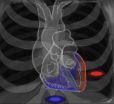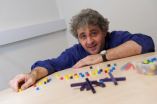(Press-News.org) Chapel Hill - A new discovery by UNC scientists describes how cells infected by the Epstein-Barr virus (EBV) produce small vesicles or sacs called exosomes, changing their cellular "cargo" of proteins and RNA. This altered exosome enters cells and can change the growth of recipient cells from benign to cancer-producing.
In this way, virus-infected cells can have wide-ranging effects and potentially manipulate other cells throughout the body. The findings are reported in the November 8, 2010 early online edition of the Proceedings of the National Academy of Sciences.
Nancy Raab-Traub, PhD, professor of microbiology and Immunology, said, "Exosomes may be the Trojan Horse through which EBV gains control of cells that are not even infected. Importantly, the production of exosomes may provide a new therapeutic target that can be blocked to reduce cancer growth." Raab-Traub is a Sarah Graham Kenan Professor and member of UNC Lineberger Comprehensive Cancer Center.
Epstein-Barr Virus (EBV) is perhaps the world's most successful virus as almost everyone is infected with it for life. EBV cannot be eliminated by the immune system and is constantly secreted into saliva where it is effectively transmitted. Infection with the virus rarely causes disease; however, EBV is found in several major cancers, including lymphoma and cancer of the nose and throat, where its proteins hijack the cell's growth regulatory mechanisms to induce uncontrolled cell growth characteristic of cancer.
Through exosomes, a protein called latent membrane protein 1, that is considered the EBV oncogene, can be delivered to uninfected cells. Significantly, EBV also changes the entire contents of the exosomes to deliver cellular proteins that are also activated in cancers. This surprising finding reveals that one infected cell can have wide-ranging effects and induce the unchecked growth of neighboring cells.
The immune system is constantly on guard to identify foreign viral proteins. Through exosomal uptake, cancer cells would be stimulated to grow without the expression of proteins that "announce" infection to the immune system, thus allowing unchecked growth. The study also showed that the cells that produce blood vessels, the process called angiogenesis, readily take in the altered exosomes and are potentially induced to grow.
"The next step," explains David Meckes, PhD, postdoctoral fellow in the Raab-Traub lab and first author of the paper, "is to determine how the virus controls which proteins are sorted into exosomes and how this process could be inhibited."
INFORMATION:
Other UNC Lineberger authors, all members of the Raab-Traub laboratory, are: Kathy Shair, PhD;Aron Marquitz, PhD; Patrick Kung, PhD ; and Rachel Edwards, BS. The research was supported by a grant from the National Cancer Institute.
END
University of Toronto scientists have found that chemicals used to line junk food wrappers and microwave popcorn bags are migrating into food and being ingested by people where they are contributing to chemical contamination observed in blood.
Perfluorinated carboxylic acids or PFCAs are the breakdown products of chemicals used to make non-stick and water- and stain-repellant products ranging from kitchen pans to clothing to food packaging. PFCAs, the best known of which is perfluorooctanoic acid (PFOA), are found in humans all around the world.
"We suspected that ...
The GOES-13 satellite is watching a flurry of activity in the Atlantic Ocean today as a cold front approaches the remnants of Hurricane Tomas and threatens to swallow it in the next couple of days.
Tomas is now a remnant low pressure area is located in the Atlantic near 26 North and 68 West hundreds of miles south-southwest of Bermuda and has a minimum central pressure of 994 millibars today, Nov. 8. A cold front off the U.S. East Coast however, is stalking Tomas' remnants and moving east threatening to swallow the former hurricane.
The Geostationary Operational Environmental ...
Jal was a tropical storm when it made landfall this weekend on the east coast of India and tracked across the country while weakening into a remnant low pressure area. NASA's Terra satellite captured an image of Jal's center as it was entering eastern India and NASA's Aqua satellite captured an infrared image as it was departing the country.
This weekend, Tropical Cyclone Jal made landfall in east central India and crossed the northern coast of Tamil Nadu and southern coast of Andhra Pradesh, north of Chennai. It dropped heavy rainfall and created some flooding. Gusty ...
CHICAGO --- Northwestern Medicine researchers at the Robert H. Lurie Comprehensive Cancer Center of Northwestern University have found that a new, nontoxic drug made from a chemical in soy could prevent the movement of cancer cells from the prostate to the rest of the body.
These findings will be presented at the Ninth Annual American Association for Cancer Research Frontiers in Cancer Prevention Research Conference.
Genistein, a natural chemical found in soy, is being used in the lab of Raymond Bergan, M.D., the director of experimental therapeutics at the Lurie Cancer ...
Saying goodbye to summer can be difficult for everybody. In some people the onset of winter triggers Seasonal Affective Disorder, or SAD, a mood disorder in which sufferers experience symptoms of depression. Happily, a special kind of gerbil exhibits remarkably similar reactions to SAD treatments as humans, opening a promising new channel for study and treatment of the common complaint.
With her work on the Israeli desert inhabitant gerbil called the Fat Sand Rat (Psammomys obesus), Prof. Noga Kronfeld-Schor of Tel Aviv University's Department of Zoology and her fellow ...
New techniques now being used at UCLA allow doctors to more precisely target certain areas of the heart to stop ventricular arrhythmias — serious abnormal rhythms in the heart's lower chambers — in high-risk patients.
Generally, arrhythmias can be controlled by medications, and sometimes defibrillators. But a potentially life-threatening, recurrent arrhythmia known as a ventricular tachycardia, which originates in one of the heart's two ventricles, can produce a fast heart beat that requires other interventions, such as catheter ablation, in which the precise focus ...
Children with learning difficulties can benefit from being encouraged to find their own way to solve arithmetic problems, according to new research from the University of Strathclyde in Glasgow, Scotland.
A study by Dr Lio Moscardini, in Strathclyde's Faculty of Humanities & Social Sciences, found that children deal better with arithmetical problems if they can use their own intuitive strategies such as using number blocks, drawings or breaking an equation up into smaller, simpler parts- rather than being instructed in arithmetical facts and procedures.
All the teachers ...
Irvine, Calif., Nov. 8, 2010 — A small amount of bleeding in the brain seems to be common among older individuals, according to a UC Irvine study.
Neurologist Dr. Mark Fisher and neuropathologist Dr. Ronald Kim found that cerebral microbleeds are highly prevalent in the aging brain – and not primarily products of stroke-related injury, hypertension or neurodegenerative diseases such as Alzheimer's, as had been thought.
"Prior work relied on brain imaging to show cerebral microbleeds," Fisher said. "But in this study, deep regions of the brain were closely examined under ...
AUDIO:
New research that reveals the activity of nerve cells in a songbird's brain as the bird sings a specific song is helping scientists to understand how birds string together sets...
Click here for more information.
A team of scientists has observed the activity of nerve cells in a songbird's brain as it is singing a particular song. Dezhe Jin, an assistant professor in the Department of Physics at Penn State University and one of the study's authors, explained that ...
Hoboken, NJ – Stevens Institute of Technology and the Netherlands Organization for Applied Scientific Research (TNO) have recently conducted joint experiments in the Dutch Navy Harbor of Den Helder, where passive acoustic systems from both parties were combined. Initial experimental results are presented at the Waterside Security (WSS) 2010 conference. This important experimental campaign was financed by the Netherlands Ministry of Defence.
The collaboration between Stevens and TNO was initiated in early 2010 after recognizing a strategic opportunity to form a long-term ...





